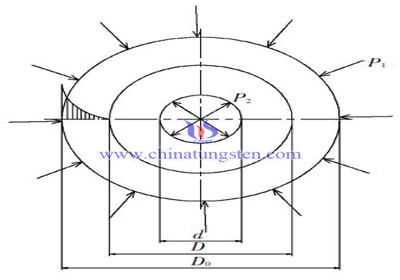Calculation of Insert Interference
- Details
- Category: Tungsten Information
- Published on Thursday, 04 January 2018 18:39
Traditionally, the tungsten carbide die inserts are welded and heated with copper. If the tungsten carbide die and the mold sleeve are fitted with interference, it is necessary to use the steel material in combination with the hard alloy.
It is the time to select the reasonable amount of interference and carry out the rough machining of the assembly surface. The reasonable selection of the insert interference of the die sleeve plays a very important role in the tungsten carbide die, which needs to be obtained through careful calculation.

Strength Calculation
If the strength of the mold sleeve is insufficient, it will easily break when the set and press are pressed. Usually, the strength of the mold sleeve can be calculated as follows.
σ=P1D12/D22-D12(1+D22/4r2)+P2D32/D22-D32(1+D12/4r2) (1)
Where σ-- Strength of die sleeve,
P1—Prestress of die sleeve,
P2--Lateral stress,
r--Distance from any point on the mold to the center,
D1-- External diameter of female die,
D2-- External diameter of die sleeve,
D3-- External diameter of the inner hole of a die.
When σ< the strength of the material, the size of the mold sleeve is suitable and safe.
Calculation of Pretightening Force of Die Sleeve and Die
P1=ΔD3/{D1/E1[(D22+D12)/(D22-D12)+μ1]+D1/E2[(D12+D32)/(D12-D32)-μ2]} (2)
Where P1-- pretightening force,
ΔD3—interference,
E1-- Modulus of elasticity of mold sleeve,
E2-- Modulus of elasticity of die,
μ1-- Poisson ratio of die sleeve,
μ2-- Poisson ratio of die.
Attention Point:
1, If the pretightening force is too large, the wire cutting will cause serious damage to the relative balance state of the internal stress in the mold material, and even cause the cracking.
2, The taper and ellipticity of the outer circle of the die and the inner hole of the die sleeve are as small as possible, so as to avoid the large local pretightening force and cause the stress concentration and crack.
3, When cutting, the thickness of the wall should be as small as possible (the wall thickness 1-4mm is suitable) to reduce the stress and deformation.
- Tungsten Carbide Manufacturer & Supplier, Chinatungsten Online: tungsten-carbide.com.cn
- Tungsten News & Prices of China Tungsten Industry Association: www.ctia.com.cn
- Molybdenum News & Price: news.molybdenum.com.cn
- Tel.: 86 592 5129696; Fax: 86 592 5129797; Email: sales@chinatungsten.com



 sales@chinatungsten.com
sales@chinatungsten.com